Financial Management Study Material
VerifiedAdded on 2023/04/17
|14
|2455
|379
AI Summary
This study material provides information on financial management, including tables and calculations for different scenarios. It covers topics such as investment, rate of return, and value of products. Suitable for students studying financial management.
Contribute Materials
Your contribution can guide someone’s learning journey. Share your
documents today.

Financial management
Secure Best Marks with AI Grader
Need help grading? Try our AI Grader for instant feedback on your assignments.
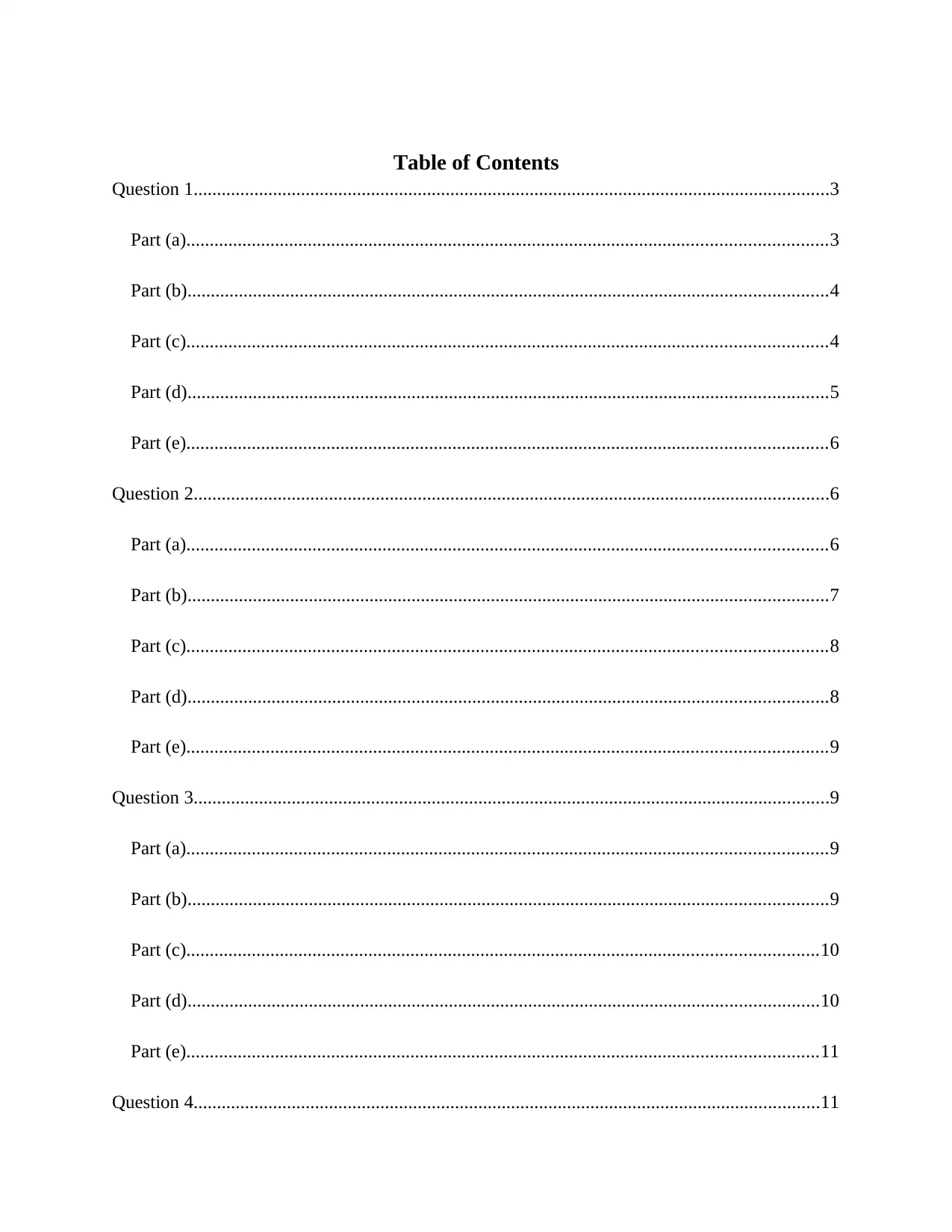
Table of Contents
Question 1........................................................................................................................................3
Part (a).........................................................................................................................................3
Part (b).........................................................................................................................................4
Part (c).........................................................................................................................................4
Part (d).........................................................................................................................................5
Part (e).........................................................................................................................................6
Question 2........................................................................................................................................6
Part (a).........................................................................................................................................6
Part (b).........................................................................................................................................7
Part (c).........................................................................................................................................8
Part (d).........................................................................................................................................8
Part (e).........................................................................................................................................9
Question 3........................................................................................................................................9
Part (a).........................................................................................................................................9
Part (b).........................................................................................................................................9
Part (c).......................................................................................................................................10
Part (d).......................................................................................................................................10
Part (e).......................................................................................................................................11
Question 4......................................................................................................................................11
Question 1........................................................................................................................................3
Part (a).........................................................................................................................................3
Part (b).........................................................................................................................................4
Part (c).........................................................................................................................................4
Part (d).........................................................................................................................................5
Part (e).........................................................................................................................................6
Question 2........................................................................................................................................6
Part (a).........................................................................................................................................6
Part (b).........................................................................................................................................7
Part (c).........................................................................................................................................8
Part (d).........................................................................................................................................8
Part (e).........................................................................................................................................9
Question 3........................................................................................................................................9
Part (a).........................................................................................................................................9
Part (b).........................................................................................................................................9
Part (c).......................................................................................................................................10
Part (d).......................................................................................................................................10
Part (e).......................................................................................................................................11
Question 4......................................................................................................................................11
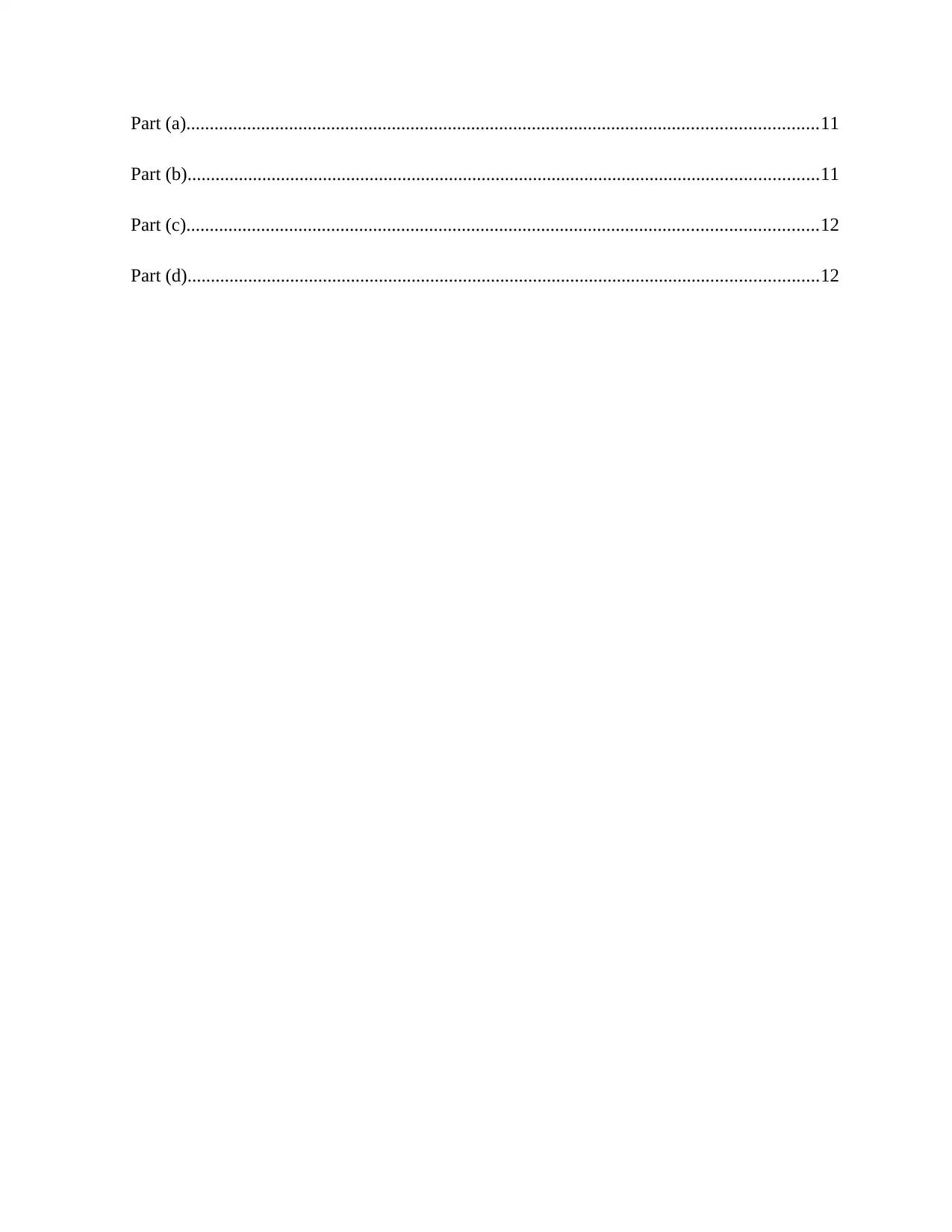
Part (a).......................................................................................................................................11
Part (b).......................................................................................................................................11
Part (c).......................................................................................................................................12
Part (d).......................................................................................................................................12
Part (b).......................................................................................................................................11
Part (c).......................................................................................................................................12
Part (d).......................................................................................................................................12
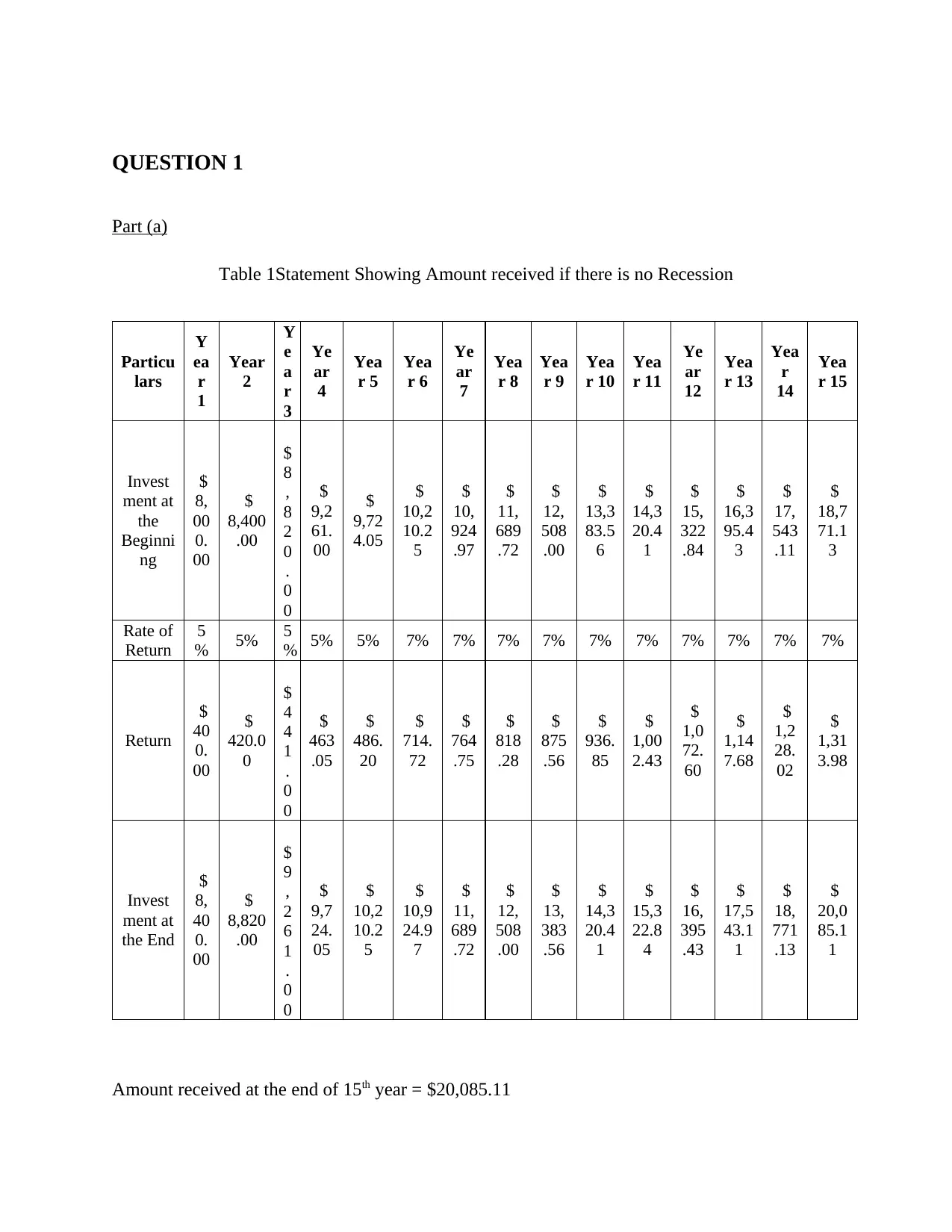
QUESTION 1
Part (a)
Table 1Statement Showing Amount received if there is no Recession
Particu
lars
Y
ea
r
1
Year
2
Y
e
a
r
3
Ye
ar
4
Yea
r 5
Yea
r 6
Ye
ar
7
Yea
r 8
Yea
r 9
Yea
r 10
Yea
r 11
Ye
ar
12
Yea
r 13
Yea
r
14
Yea
r 15
Invest
ment at
the
Beginni
ng
$
8,
00
0.
00
$
8,400
.00
$
8
,
8
2
0
.
0
0
$
9,2
61.
00
$
9,72
4.05
$
10,2
10.2
5
$
10,
924
.97
$
11,
689
.72
$
12,
508
.00
$
13,3
83.5
6
$
14,3
20.4
1
$
15,
322
.84
$
16,3
95.4
3
$
17,
543
.11
$
18,7
71.1
3
Rate of
Return
5
% 5% 5
% 5% 5% 7% 7% 7% 7% 7% 7% 7% 7% 7% 7%
Return
$
40
0.
00
$
420.0
0
$
4
4
1
.
0
0
$
463
.05
$
486.
20
$
714.
72
$
764
.75
$
818
.28
$
875
.56
$
936.
85
$
1,00
2.43
$
1,0
72.
60
$
1,14
7.68
$
1,2
28.
02
$
1,31
3.98
Invest
ment at
the End
$
8,
40
0.
00
$
8,820
.00
$
9
,
2
6
1
.
0
0
$
9,7
24.
05
$
10,2
10.2
5
$
10,9
24.9
7
$
11,
689
.72
$
12,
508
.00
$
13,
383
.56
$
14,3
20.4
1
$
15,3
22.8
4
$
16,
395
.43
$
17,5
43.1
1
$
18,
771
.13
$
20,0
85.1
1
Amount received at the end of 15th year = $20,085.11
Part (a)
Table 1Statement Showing Amount received if there is no Recession
Particu
lars
Y
ea
r
1
Year
2
Y
e
a
r
3
Ye
ar
4
Yea
r 5
Yea
r 6
Ye
ar
7
Yea
r 8
Yea
r 9
Yea
r 10
Yea
r 11
Ye
ar
12
Yea
r 13
Yea
r
14
Yea
r 15
Invest
ment at
the
Beginni
ng
$
8,
00
0.
00
$
8,400
.00
$
8
,
8
2
0
.
0
0
$
9,2
61.
00
$
9,72
4.05
$
10,2
10.2
5
$
10,
924
.97
$
11,
689
.72
$
12,
508
.00
$
13,3
83.5
6
$
14,3
20.4
1
$
15,
322
.84
$
16,3
95.4
3
$
17,
543
.11
$
18,7
71.1
3
Rate of
Return
5
% 5% 5
% 5% 5% 7% 7% 7% 7% 7% 7% 7% 7% 7% 7%
Return
$
40
0.
00
$
420.0
0
$
4
4
1
.
0
0
$
463
.05
$
486.
20
$
714.
72
$
764
.75
$
818
.28
$
875
.56
$
936.
85
$
1,00
2.43
$
1,0
72.
60
$
1,14
7.68
$
1,2
28.
02
$
1,31
3.98
Invest
ment at
the End
$
8,
40
0.
00
$
8,820
.00
$
9
,
2
6
1
.
0
0
$
9,7
24.
05
$
10,2
10.2
5
$
10,9
24.9
7
$
11,
689
.72
$
12,
508
.00
$
13,
383
.56
$
14,3
20.4
1
$
15,3
22.8
4
$
16,
395
.43
$
17,5
43.1
1
$
18,
771
.13
$
20,0
85.1
1
Amount received at the end of 15th year = $20,085.11
Secure Best Marks with AI Grader
Need help grading? Try our AI Grader for instant feedback on your assignments.
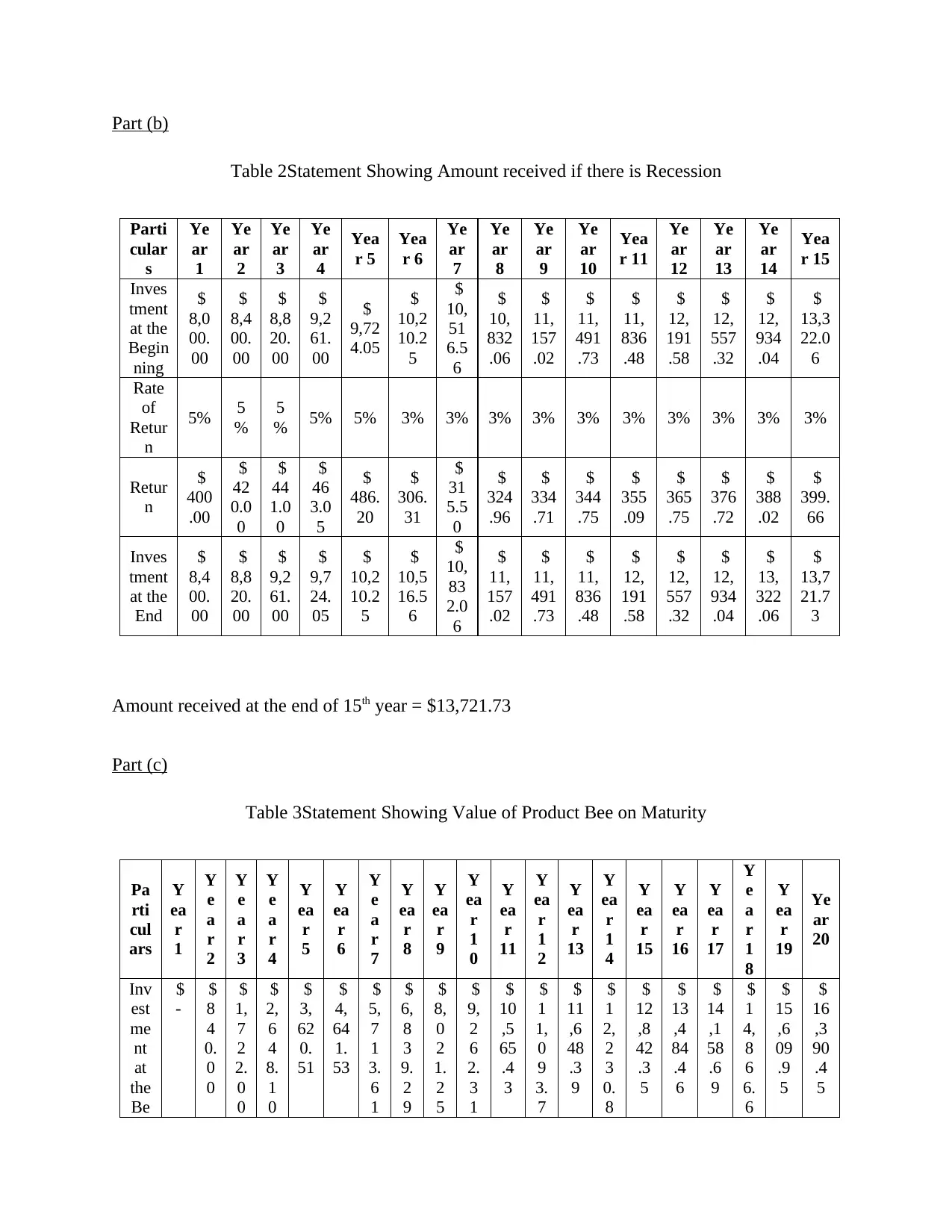
Part (b)
Table 2Statement Showing Amount received if there is Recession
Parti
cular
s
Ye
ar
1
Ye
ar
2
Ye
ar
3
Ye
ar
4
Yea
r 5
Yea
r 6
Ye
ar
7
Ye
ar
8
Ye
ar
9
Ye
ar
10
Yea
r 11
Ye
ar
12
Ye
ar
13
Ye
ar
14
Yea
r 15
Inves
tment
at the
Begin
ning
$
8,0
00.
00
$
8,4
00.
00
$
8,8
20.
00
$
9,2
61.
00
$
9,72
4.05
$
10,2
10.2
5
$
10,
51
6.5
6
$
10,
832
.06
$
11,
157
.02
$
11,
491
.73
$
11,
836
.48
$
12,
191
.58
$
12,
557
.32
$
12,
934
.04
$
13,3
22.0
6
Rate
of
Retur
n
5% 5
%
5
% 5% 5% 3% 3% 3% 3% 3% 3% 3% 3% 3% 3%
Retur
n
$
400
.00
$
42
0.0
0
$
44
1.0
0
$
46
3.0
5
$
486.
20
$
306.
31
$
31
5.5
0
$
324
.96
$
334
.71
$
344
.75
$
355
.09
$
365
.75
$
376
.72
$
388
.02
$
399.
66
Inves
tment
at the
End
$
8,4
00.
00
$
8,8
20.
00
$
9,2
61.
00
$
9,7
24.
05
$
10,2
10.2
5
$
10,5
16.5
6
$
10,
83
2.0
6
$
11,
157
.02
$
11,
491
.73
$
11,
836
.48
$
12,
191
.58
$
12,
557
.32
$
12,
934
.04
$
13,
322
.06
$
13,7
21.7
3
Amount received at the end of 15th year = $13,721.73
Part (c)
Table 3Statement Showing Value of Product Bee on Maturity
Pa
rti
cul
ars
Y
ea
r
1
Y
e
a
r
2
Y
e
a
r
3
Y
e
a
r
4
Y
ea
r
5
Y
ea
r
6
Y
e
a
r
7
Y
ea
r
8
Y
ea
r
9
Y
ea
r
1
0
Y
ea
r
11
Y
ea
r
1
2
Y
ea
r
13
Y
ea
r
1
4
Y
ea
r
15
Y
ea
r
16
Y
ea
r
17
Y
e
a
r
1
8
Y
ea
r
19
Ye
ar
20
Inv
est
me
nt
at
the
Be
$
-
$
8
4
0.
0
0
$
1,
7
2
2.
0
0
$
2,
6
4
8.
1
0
$
3,
62
0.
51
$
4,
64
1.
53
$
5,
7
1
3.
6
1
$
6,
8
3
9.
2
9
$
8,
0
2
1.
2
5
$
9,
2
6
2.
3
1
$
10
,5
65
.4
3
$
1
1,
0
9
3.
7
$
11
,6
48
.3
9
$
1
2,
2
3
0.
8
$
12
,8
42
.3
5
$
13
,4
84
.4
6
$
14
,1
58
.6
9
$
1
4,
8
6
6.
6
$
15
,6
09
.9
5
$
16
,3
90
.4
5
Table 2Statement Showing Amount received if there is Recession
Parti
cular
s
Ye
ar
1
Ye
ar
2
Ye
ar
3
Ye
ar
4
Yea
r 5
Yea
r 6
Ye
ar
7
Ye
ar
8
Ye
ar
9
Ye
ar
10
Yea
r 11
Ye
ar
12
Ye
ar
13
Ye
ar
14
Yea
r 15
Inves
tment
at the
Begin
ning
$
8,0
00.
00
$
8,4
00.
00
$
8,8
20.
00
$
9,2
61.
00
$
9,72
4.05
$
10,2
10.2
5
$
10,
51
6.5
6
$
10,
832
.06
$
11,
157
.02
$
11,
491
.73
$
11,
836
.48
$
12,
191
.58
$
12,
557
.32
$
12,
934
.04
$
13,3
22.0
6
Rate
of
Retur
n
5% 5
%
5
% 5% 5% 3% 3% 3% 3% 3% 3% 3% 3% 3% 3%
Retur
n
$
400
.00
$
42
0.0
0
$
44
1.0
0
$
46
3.0
5
$
486.
20
$
306.
31
$
31
5.5
0
$
324
.96
$
334
.71
$
344
.75
$
355
.09
$
365
.75
$
376
.72
$
388
.02
$
399.
66
Inves
tment
at the
End
$
8,4
00.
00
$
8,8
20.
00
$
9,2
61.
00
$
9,7
24.
05
$
10,2
10.2
5
$
10,5
16.5
6
$
10,
83
2.0
6
$
11,
157
.02
$
11,
491
.73
$
11,
836
.48
$
12,
191
.58
$
12,
557
.32
$
12,
934
.04
$
13,
322
.06
$
13,7
21.7
3
Amount received at the end of 15th year = $13,721.73
Part (c)
Table 3Statement Showing Value of Product Bee on Maturity
Pa
rti
cul
ars
Y
ea
r
1
Y
e
a
r
2
Y
e
a
r
3
Y
e
a
r
4
Y
ea
r
5
Y
ea
r
6
Y
e
a
r
7
Y
ea
r
8
Y
ea
r
9
Y
ea
r
1
0
Y
ea
r
11
Y
ea
r
1
2
Y
ea
r
13
Y
ea
r
1
4
Y
ea
r
15
Y
ea
r
16
Y
ea
r
17
Y
e
a
r
1
8
Y
ea
r
19
Ye
ar
20
Inv
est
me
nt
at
the
Be
$
-
$
8
4
0.
0
0
$
1,
7
2
2.
0
0
$
2,
6
4
8.
1
0
$
3,
62
0.
51
$
4,
64
1.
53
$
5,
7
1
3.
6
1
$
6,
8
3
9.
2
9
$
8,
0
2
1.
2
5
$
9,
2
6
2.
3
1
$
10
,5
65
.4
3
$
1
1,
0
9
3.
7
$
11
,6
48
.3
9
$
1
2,
2
3
0.
8
$
12
,8
42
.3
5
$
13
,4
84
.4
6
$
14
,1
58
.6
9
$
1
4,
8
6
6.
6
$
15
,6
09
.9
5
$
16
,3
90
.4
5
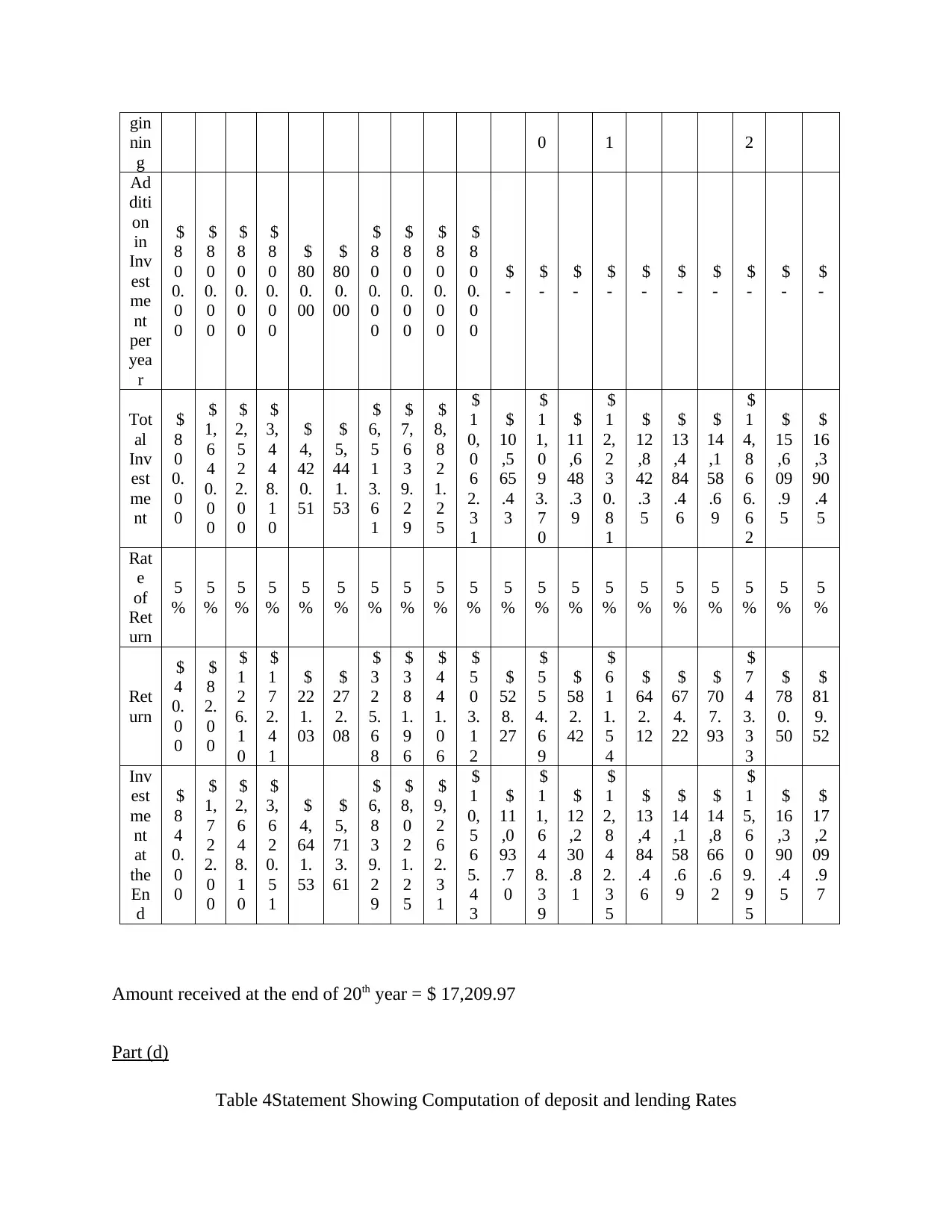
gin
nin
g
0 1 2
Ad
diti
on
in
Inv
est
me
nt
per
yea
r
$
8
0
0.
0
0
$
8
0
0.
0
0
$
8
0
0.
0
0
$
8
0
0.
0
0
$
80
0.
00
$
80
0.
00
$
8
0
0.
0
0
$
8
0
0.
0
0
$
8
0
0.
0
0
$
8
0
0.
0
0
$
-
$
-
$
-
$
-
$
-
$
-
$
-
$
-
$
-
$
-
Tot
al
Inv
est
me
nt
$
8
0
0.
0
0
$
1,
6
4
0.
0
0
$
2,
5
2
2.
0
0
$
3,
4
4
8.
1
0
$
4,
42
0.
51
$
5,
44
1.
53
$
6,
5
1
3.
6
1
$
7,
6
3
9.
2
9
$
8,
8
2
1.
2
5
$
1
0,
0
6
2.
3
1
$
10
,5
65
.4
3
$
1
1,
0
9
3.
7
0
$
11
,6
48
.3
9
$
1
2,
2
3
0.
8
1
$
12
,8
42
.3
5
$
13
,4
84
.4
6
$
14
,1
58
.6
9
$
1
4,
8
6
6.
6
2
$
15
,6
09
.9
5
$
16
,3
90
.4
5
Rat
e
of
Ret
urn
5
%
5
%
5
%
5
%
5
%
5
%
5
%
5
%
5
%
5
%
5
%
5
%
5
%
5
%
5
%
5
%
5
%
5
%
5
%
5
%
Ret
urn
$
4
0.
0
0
$
8
2.
0
0
$
1
2
6.
1
0
$
1
7
2.
4
1
$
22
1.
03
$
27
2.
08
$
3
2
5.
6
8
$
3
8
1.
9
6
$
4
4
1.
0
6
$
5
0
3.
1
2
$
52
8.
27
$
5
5
4.
6
9
$
58
2.
42
$
6
1
1.
5
4
$
64
2.
12
$
67
4.
22
$
70
7.
93
$
7
4
3.
3
3
$
78
0.
50
$
81
9.
52
Inv
est
me
nt
at
the
En
d
$
8
4
0.
0
0
$
1,
7
2
2.
0
0
$
2,
6
4
8.
1
0
$
3,
6
2
0.
5
1
$
4,
64
1.
53
$
5,
71
3.
61
$
6,
8
3
9.
2
9
$
8,
0
2
1.
2
5
$
9,
2
6
2.
3
1
$
1
0,
5
6
5.
4
3
$
11
,0
93
.7
0
$
1
1,
6
4
8.
3
9
$
12
,2
30
.8
1
$
1
2,
8
4
2.
3
5
$
13
,4
84
.4
6
$
14
,1
58
.6
9
$
14
,8
66
.6
2
$
1
5,
6
0
9.
9
5
$
16
,3
90
.4
5
$
17
,2
09
.9
7
Amount received at the end of 20th year = $ 17,209.97
Part (d)
Table 4Statement Showing Computation of deposit and lending Rates
nin
g
0 1 2
Ad
diti
on
in
Inv
est
me
nt
per
yea
r
$
8
0
0.
0
0
$
8
0
0.
0
0
$
8
0
0.
0
0
$
8
0
0.
0
0
$
80
0.
00
$
80
0.
00
$
8
0
0.
0
0
$
8
0
0.
0
0
$
8
0
0.
0
0
$
8
0
0.
0
0
$
-
$
-
$
-
$
-
$
-
$
-
$
-
$
-
$
-
$
-
Tot
al
Inv
est
me
nt
$
8
0
0.
0
0
$
1,
6
4
0.
0
0
$
2,
5
2
2.
0
0
$
3,
4
4
8.
1
0
$
4,
42
0.
51
$
5,
44
1.
53
$
6,
5
1
3.
6
1
$
7,
6
3
9.
2
9
$
8,
8
2
1.
2
5
$
1
0,
0
6
2.
3
1
$
10
,5
65
.4
3
$
1
1,
0
9
3.
7
0
$
11
,6
48
.3
9
$
1
2,
2
3
0.
8
1
$
12
,8
42
.3
5
$
13
,4
84
.4
6
$
14
,1
58
.6
9
$
1
4,
8
6
6.
6
2
$
15
,6
09
.9
5
$
16
,3
90
.4
5
Rat
e
of
Ret
urn
5
%
5
%
5
%
5
%
5
%
5
%
5
%
5
%
5
%
5
%
5
%
5
%
5
%
5
%
5
%
5
%
5
%
5
%
5
%
5
%
Ret
urn
$
4
0.
0
0
$
8
2.
0
0
$
1
2
6.
1
0
$
1
7
2.
4
1
$
22
1.
03
$
27
2.
08
$
3
2
5.
6
8
$
3
8
1.
9
6
$
4
4
1.
0
6
$
5
0
3.
1
2
$
52
8.
27
$
5
5
4.
6
9
$
58
2.
42
$
6
1
1.
5
4
$
64
2.
12
$
67
4.
22
$
70
7.
93
$
7
4
3.
3
3
$
78
0.
50
$
81
9.
52
Inv
est
me
nt
at
the
En
d
$
8
4
0.
0
0
$
1,
7
2
2.
0
0
$
2,
6
4
8.
1
0
$
3,
6
2
0.
5
1
$
4,
64
1.
53
$
5,
71
3.
61
$
6,
8
3
9.
2
9
$
8,
0
2
1.
2
5
$
9,
2
6
2.
3
1
$
1
0,
5
6
5.
4
3
$
11
,0
93
.7
0
$
1
1,
6
4
8.
3
9
$
12
,2
30
.8
1
$
1
2,
8
4
2.
3
5
$
13
,4
84
.4
6
$
14
,1
58
.6
9
$
14
,8
66
.6
2
$
1
5,
6
0
9.
9
5
$
16
,3
90
.4
5
$
17
,2
09
.9
7
Amount received at the end of 20th year = $ 17,209.97
Part (d)
Table 4Statement Showing Computation of deposit and lending Rates
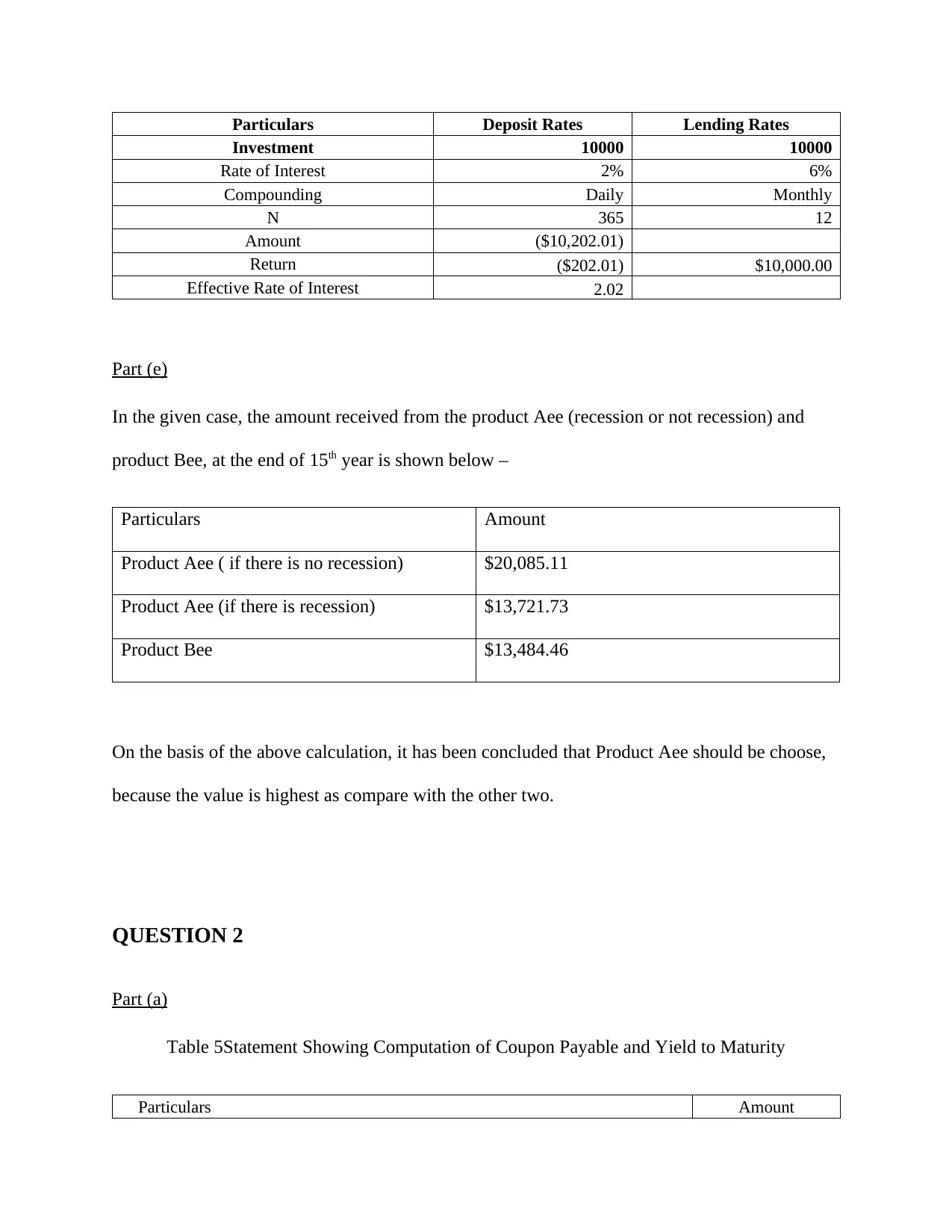
Particulars Deposit Rates Lending Rates
Investment 10000 10000
Rate of Interest 2% 6%
Compounding Daily Monthly
N 365 12
Amount ($10,202.01)
Return ($202.01) $10,000.00
Effective Rate of Interest 2.02
Part (e)
In the given case, the amount received from the product Aee (recession or not recession) and
product Bee, at the end of 15th year is shown below –
Particulars Amount
Product Aee ( if there is no recession) $20,085.11
Product Aee (if there is recession) $13,721.73
Product Bee $13,484.46
On the basis of the above calculation, it has been concluded that Product Aee should be choose,
because the value is highest as compare with the other two.
QUESTION 2
Part (a)
Table 5Statement Showing Computation of Coupon Payable and Yield to Maturity
Particulars Amount
Investment 10000 10000
Rate of Interest 2% 6%
Compounding Daily Monthly
N 365 12
Amount ($10,202.01)
Return ($202.01) $10,000.00
Effective Rate of Interest 2.02
Part (e)
In the given case, the amount received from the product Aee (recession or not recession) and
product Bee, at the end of 15th year is shown below –
Particulars Amount
Product Aee ( if there is no recession) $20,085.11
Product Aee (if there is recession) $13,721.73
Product Bee $13,484.46
On the basis of the above calculation, it has been concluded that Product Aee should be choose,
because the value is highest as compare with the other two.
QUESTION 2
Part (a)
Table 5Statement Showing Computation of Coupon Payable and Yield to Maturity
Particulars Amount
Paraphrase This Document
Need a fresh take? Get an instant paraphrase of this document with our AI Paraphraser
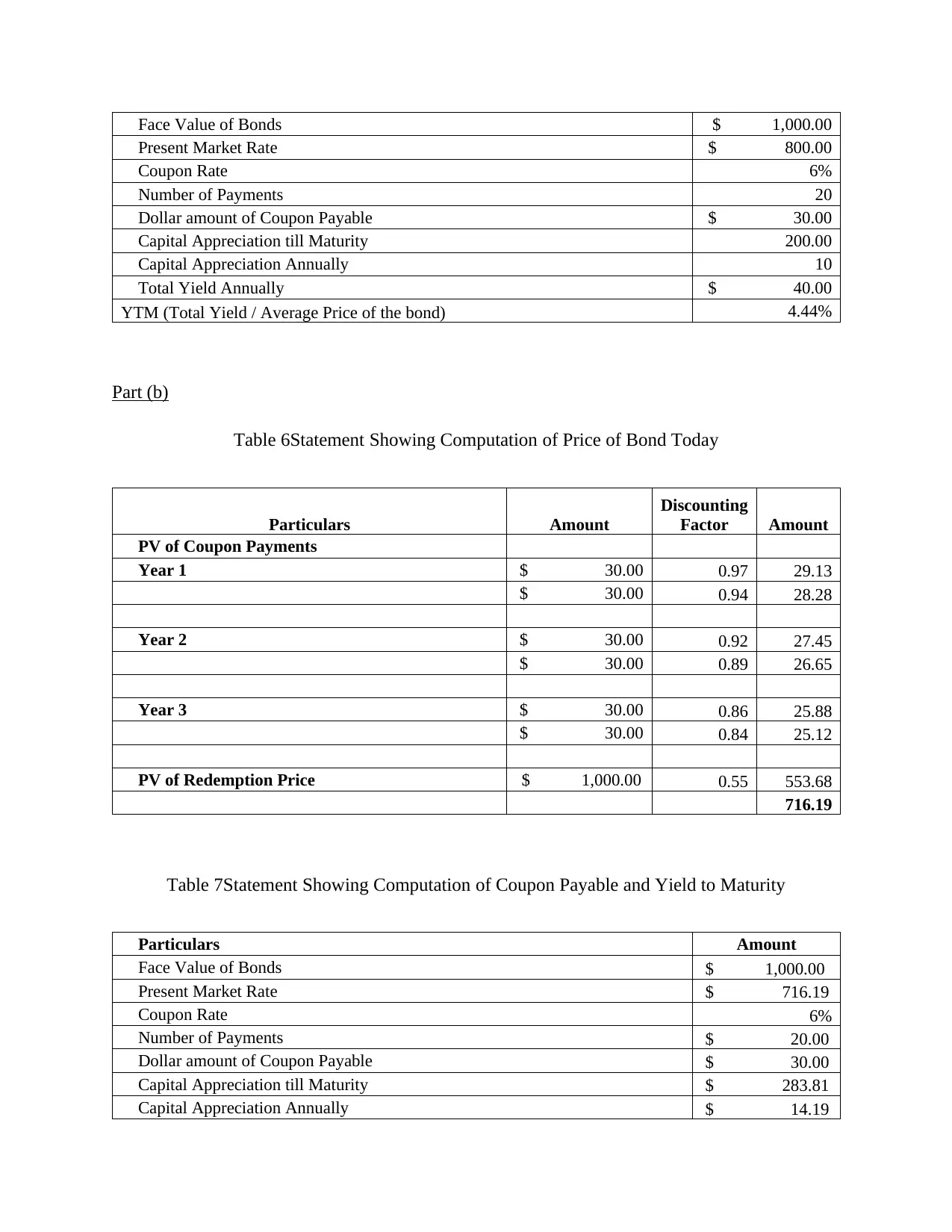
Face Value of Bonds $ 1,000.00
Present Market Rate $ 800.00
Coupon Rate 6%
Number of Payments 20
Dollar amount of Coupon Payable $ 30.00
Capital Appreciation till Maturity 200.00
Capital Appreciation Annually 10
Total Yield Annually $ 40.00
YTM (Total Yield / Average Price of the bond) 4.44%
Part (b)
Table 6Statement Showing Computation of Price of Bond Today
Particulars Amount
Discounting
Factor Amount
PV of Coupon Payments
Year 1 $ 30.00 0.97 29.13
$ 30.00 0.94 28.28
Year 2 $ 30.00 0.92 27.45
$ 30.00 0.89 26.65
Year 3 $ 30.00 0.86 25.88
$ 30.00 0.84 25.12
PV of Redemption Price $ 1,000.00 0.55 553.68
716.19
Table 7Statement Showing Computation of Coupon Payable and Yield to Maturity
Particulars Amount
Face Value of Bonds $ 1,000.00
Present Market Rate $ 716.19
Coupon Rate 6%
Number of Payments $ 20.00
Dollar amount of Coupon Payable $ 30.00
Capital Appreciation till Maturity $ 283.81
Capital Appreciation Annually $ 14.19
Present Market Rate $ 800.00
Coupon Rate 6%
Number of Payments 20
Dollar amount of Coupon Payable $ 30.00
Capital Appreciation till Maturity 200.00
Capital Appreciation Annually 10
Total Yield Annually $ 40.00
YTM (Total Yield / Average Price of the bond) 4.44%
Part (b)
Table 6Statement Showing Computation of Price of Bond Today
Particulars Amount
Discounting
Factor Amount
PV of Coupon Payments
Year 1 $ 30.00 0.97 29.13
$ 30.00 0.94 28.28
Year 2 $ 30.00 0.92 27.45
$ 30.00 0.89 26.65
Year 3 $ 30.00 0.86 25.88
$ 30.00 0.84 25.12
PV of Redemption Price $ 1,000.00 0.55 553.68
716.19
Table 7Statement Showing Computation of Coupon Payable and Yield to Maturity
Particulars Amount
Face Value of Bonds $ 1,000.00
Present Market Rate $ 716.19
Coupon Rate 6%
Number of Payments $ 20.00
Dollar amount of Coupon Payable $ 30.00
Capital Appreciation till Maturity $ 283.81
Capital Appreciation Annually $ 14.19
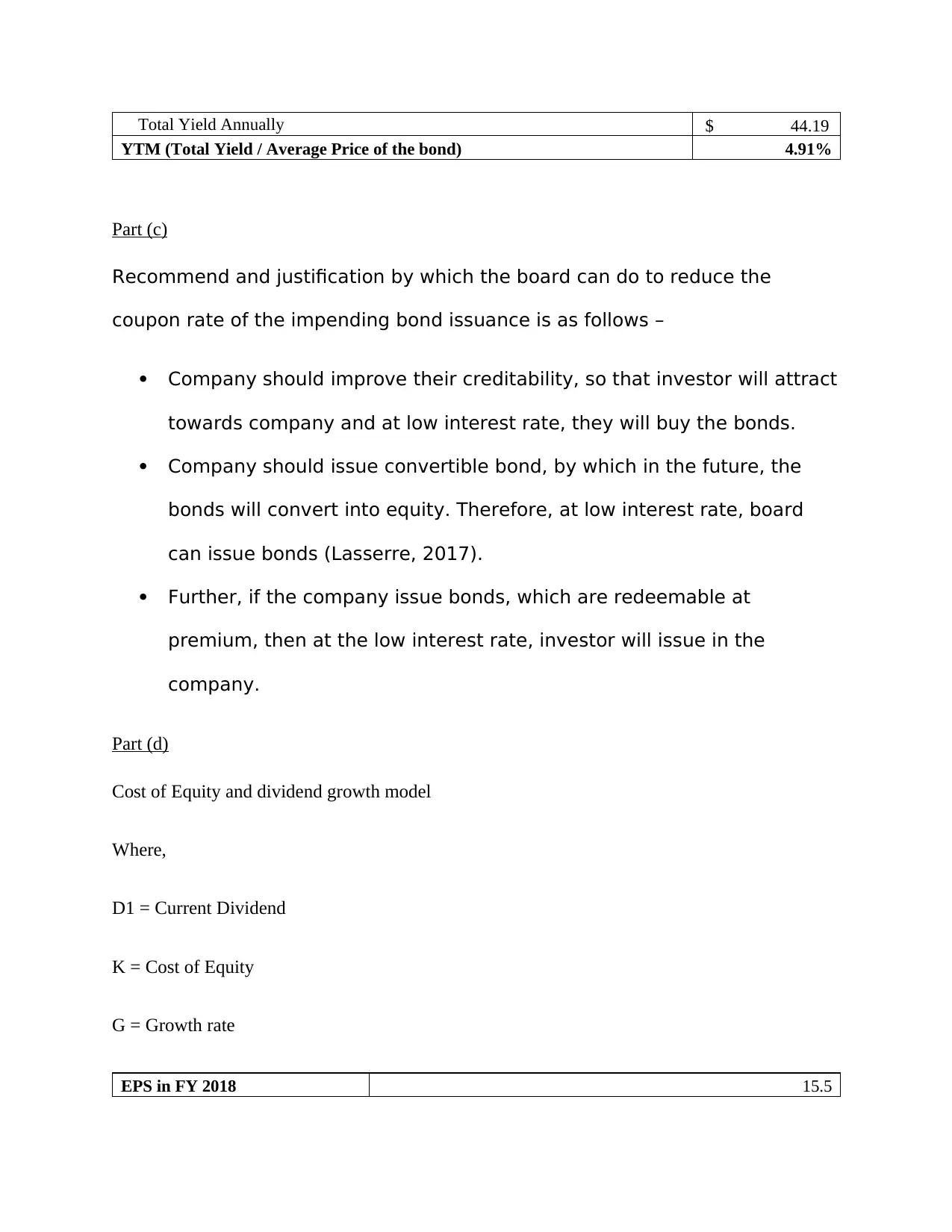
Total Yield Annually $ 44.19
YTM (Total Yield / Average Price of the bond) 4.91%
Part (c)
Recommend and justification by which the board can do to reduce the
coupon rate of the impending bond issuance is as follows –
Company should improve their creditability, so that investor will attract
towards company and at low interest rate, they will buy the bonds.
Company should issue convertible bond, by which in the future, the
bonds will convert into equity. Therefore, at low interest rate, board
can issue bonds (Lasserre, 2017).
Further, if the company issue bonds, which are redeemable at
premium, then at the low interest rate, investor will issue in the
company.
Part (d)
Cost of Equity and dividend growth model
Where,
D1 = Current Dividend
K = Cost of Equity
G = Growth rate
EPS in FY 2018 15.5
YTM (Total Yield / Average Price of the bond) 4.91%
Part (c)
Recommend and justification by which the board can do to reduce the
coupon rate of the impending bond issuance is as follows –
Company should improve their creditability, so that investor will attract
towards company and at low interest rate, they will buy the bonds.
Company should issue convertible bond, by which in the future, the
bonds will convert into equity. Therefore, at low interest rate, board
can issue bonds (Lasserre, 2017).
Further, if the company issue bonds, which are redeemable at
premium, then at the low interest rate, investor will issue in the
company.
Part (d)
Cost of Equity and dividend growth model
Where,
D1 = Current Dividend
K = Cost of Equity
G = Growth rate
EPS in FY 2018 15.5
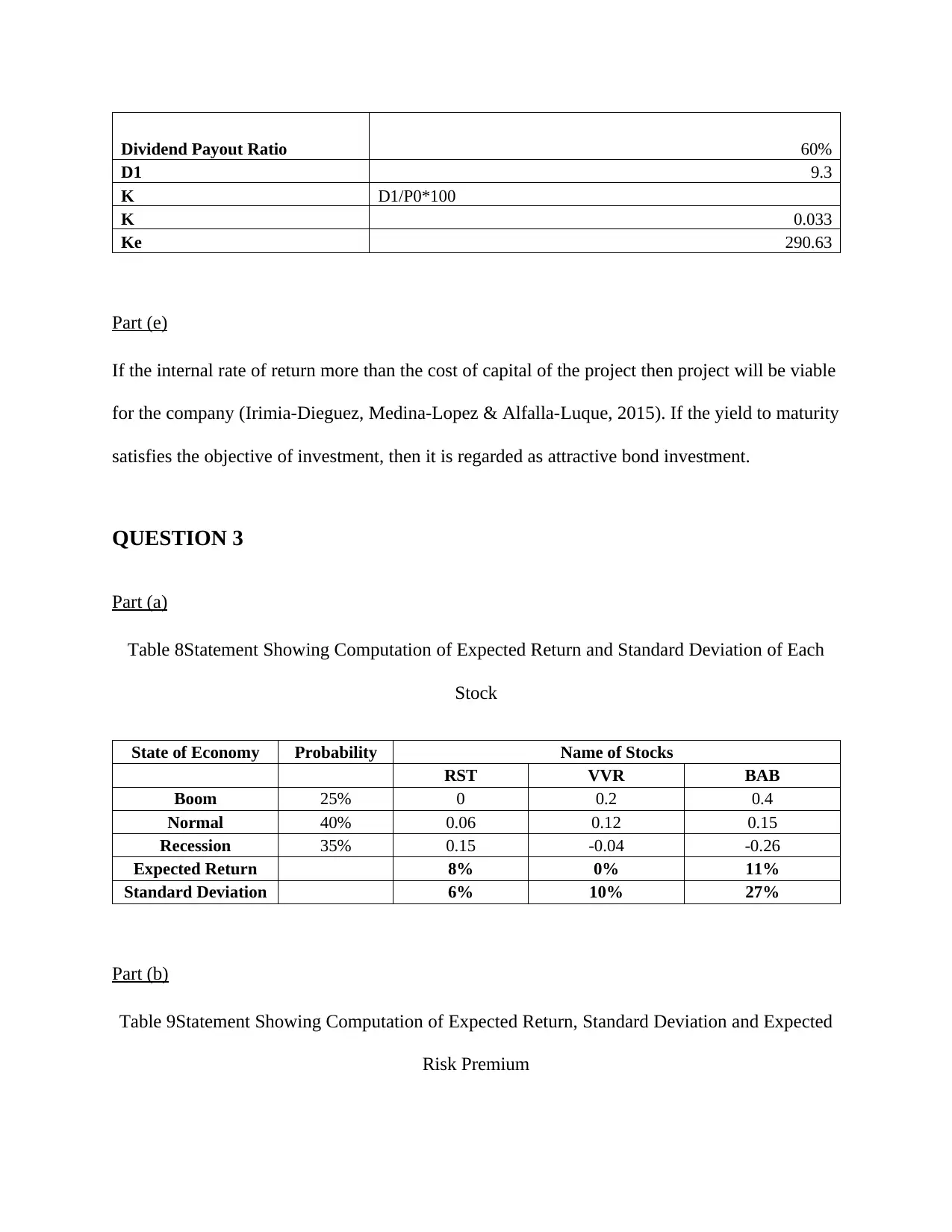
Dividend Payout Ratio 60%
D1 9.3
K D1/P0*100
K 0.033
Ke 290.63
Part (e)
If the internal rate of return more than the cost of capital of the project then project will be viable
for the company (Irimia-Dieguez, Medina-Lopez & Alfalla-Luque, 2015). If the yield to maturity
satisfies the objective of investment, then it is regarded as attractive bond investment.
QUESTION 3
Part (a)
Table 8Statement Showing Computation of Expected Return and Standard Deviation of Each
Stock
State of Economy Probability Name of Stocks
RST VVR BAB
Boom 25% 0 0.2 0.4
Normal 40% 0.06 0.12 0.15
Recession 35% 0.15 -0.04 -0.26
Expected Return 8% 0% 11%
Standard Deviation 6% 10% 27%
Part (b)
Table 9Statement Showing Computation of Expected Return, Standard Deviation and Expected
Risk Premium
D1 9.3
K D1/P0*100
K 0.033
Ke 290.63
Part (e)
If the internal rate of return more than the cost of capital of the project then project will be viable
for the company (Irimia-Dieguez, Medina-Lopez & Alfalla-Luque, 2015). If the yield to maturity
satisfies the objective of investment, then it is regarded as attractive bond investment.
QUESTION 3
Part (a)
Table 8Statement Showing Computation of Expected Return and Standard Deviation of Each
Stock
State of Economy Probability Name of Stocks
RST VVR BAB
Boom 25% 0 0.2 0.4
Normal 40% 0.06 0.12 0.15
Recession 35% 0.15 -0.04 -0.26
Expected Return 8% 0% 11%
Standard Deviation 6% 10% 27%
Part (b)
Table 9Statement Showing Computation of Expected Return, Standard Deviation and Expected
Risk Premium
Secure Best Marks with AI Grader
Need help grading? Try our AI Grader for instant feedback on your assignments.

State of Economy Name of Stocks
RST VVR BAB
Expected Return 8% 0% 11%
Standard Deviation 6% 10% 27%
Respective Weights 0.4 0.3 0.3
Expected Return on Portfolio 6%
Standard Deviation on Portfolio 14%
Expected Risk Premium
(Expected Rate of Return - Risk Free
Rate) 3%
Risk Free Rate 3%
Part (c)
By considering the above calculations, it has been seen that the expected return from the stock
VVR is zero. Further, stock BAB provides the highest return as compare with the stock RST. On
the other hand, Risk in the stock BAB is highest. There is significant difference in the risk of
RST stock and BAB stock, however the difference between the expected return of these stock is
not substantial. On the basis of this, it is advisable to Ravi that he should allocate its asset on the
RST stock.
Part (d)
Calculation of the market risk premium as per capital asset pricing model
Market risk premium = Expected Return on the market portfolio – Risk Free rate of return
= 6%-3%
= 3%
RST VVR BAB
Expected Return 8% 0% 11%
Standard Deviation 6% 10% 27%
Respective Weights 0.4 0.3 0.3
Expected Return on Portfolio 6%
Standard Deviation on Portfolio 14%
Expected Risk Premium
(Expected Rate of Return - Risk Free
Rate) 3%
Risk Free Rate 3%
Part (c)
By considering the above calculations, it has been seen that the expected return from the stock
VVR is zero. Further, stock BAB provides the highest return as compare with the stock RST. On
the other hand, Risk in the stock BAB is highest. There is significant difference in the risk of
RST stock and BAB stock, however the difference between the expected return of these stock is
not substantial. On the basis of this, it is advisable to Ravi that he should allocate its asset on the
RST stock.
Part (d)
Calculation of the market risk premium as per capital asset pricing model
Market risk premium = Expected Return on the market portfolio – Risk Free rate of return
= 6%-3%
= 3%
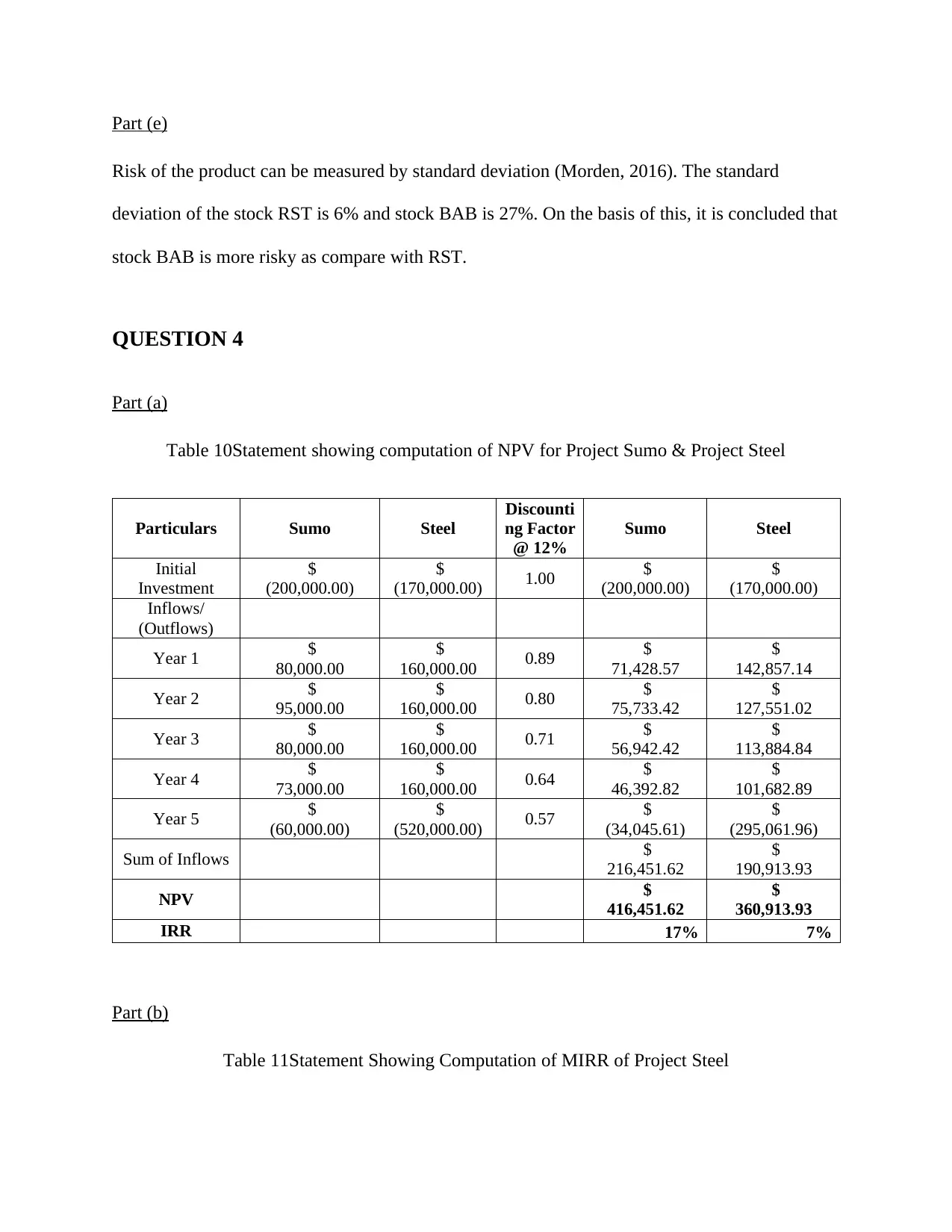
Part (e)
Risk of the product can be measured by standard deviation (Morden, 2016). The standard
deviation of the stock RST is 6% and stock BAB is 27%. On the basis of this, it is concluded that
stock BAB is more risky as compare with RST.
QUESTION 4
Part (a)
Table 10Statement showing computation of NPV for Project Sumo & Project Steel
Particulars Sumo Steel
Discounti
ng Factor
@ 12%
Sumo Steel
Initial
Investment
$
(200,000.00)
$
(170,000.00) 1.00 $
(200,000.00)
$
(170,000.00)
Inflows/
(Outflows)
Year 1 $
80,000.00
$
160,000.00 0.89 $
71,428.57
$
142,857.14
Year 2 $
95,000.00
$
160,000.00 0.80 $
75,733.42
$
127,551.02
Year 3 $
80,000.00
$
160,000.00 0.71 $
56,942.42
$
113,884.84
Year 4 $
73,000.00
$
160,000.00 0.64 $
46,392.82
$
101,682.89
Year 5 $
(60,000.00)
$
(520,000.00) 0.57 $
(34,045.61)
$
(295,061.96)
Sum of Inflows $
216,451.62
$
190,913.93
NPV $
416,451.62
$
360,913.93
IRR 17% 7%
Part (b)
Table 11Statement Showing Computation of MIRR of Project Steel
Risk of the product can be measured by standard deviation (Morden, 2016). The standard
deviation of the stock RST is 6% and stock BAB is 27%. On the basis of this, it is concluded that
stock BAB is more risky as compare with RST.
QUESTION 4
Part (a)
Table 10Statement showing computation of NPV for Project Sumo & Project Steel
Particulars Sumo Steel
Discounti
ng Factor
@ 12%
Sumo Steel
Initial
Investment
$
(200,000.00)
$
(170,000.00) 1.00 $
(200,000.00)
$
(170,000.00)
Inflows/
(Outflows)
Year 1 $
80,000.00
$
160,000.00 0.89 $
71,428.57
$
142,857.14
Year 2 $
95,000.00
$
160,000.00 0.80 $
75,733.42
$
127,551.02
Year 3 $
80,000.00
$
160,000.00 0.71 $
56,942.42
$
113,884.84
Year 4 $
73,000.00
$
160,000.00 0.64 $
46,392.82
$
101,682.89
Year 5 $
(60,000.00)
$
(520,000.00) 0.57 $
(34,045.61)
$
(295,061.96)
Sum of Inflows $
216,451.62
$
190,913.93
NPV $
416,451.62
$
360,913.93
IRR 17% 7%
Part (b)
Table 11Statement Showing Computation of MIRR of Project Steel
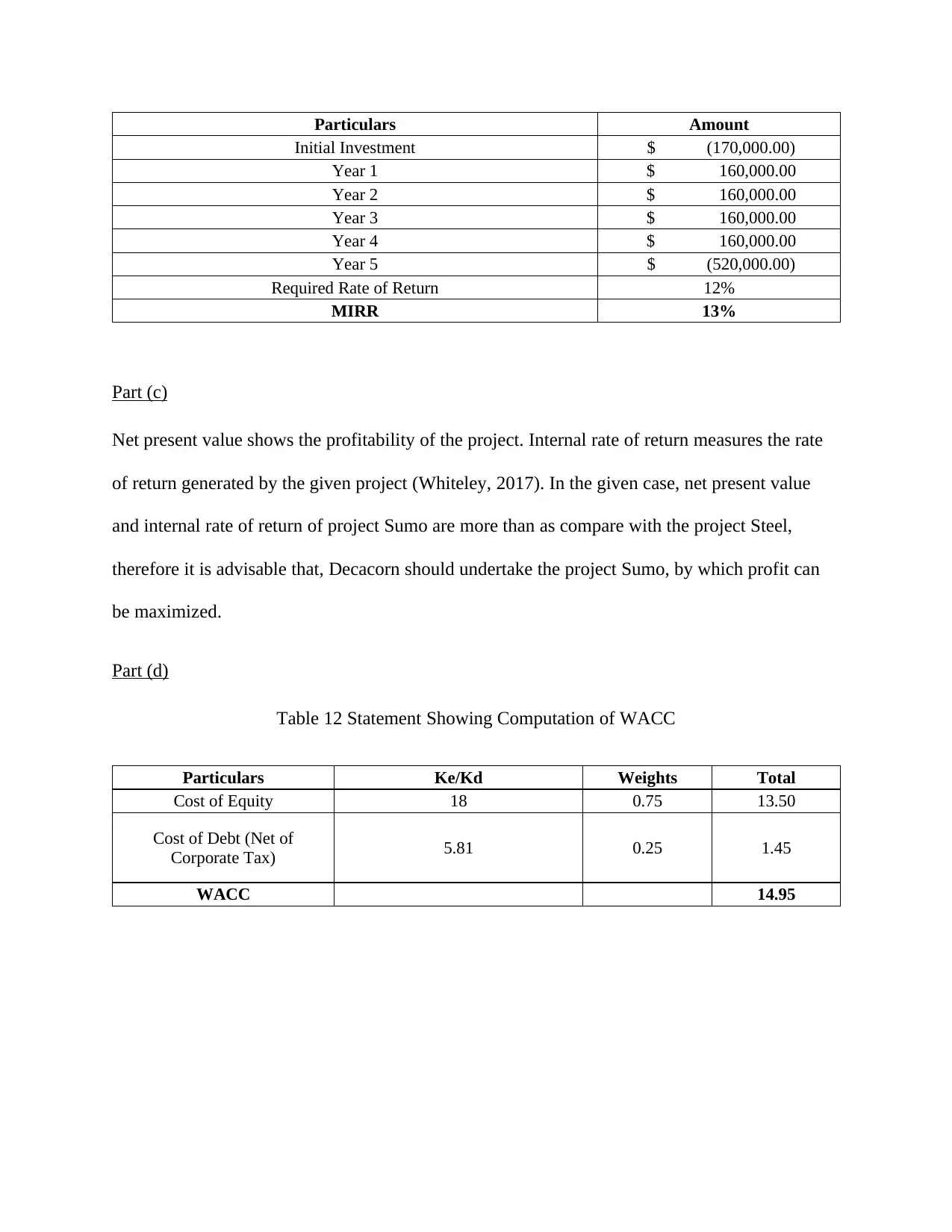
Particulars Amount
Initial Investment $ (170,000.00)
Year 1 $ 160,000.00
Year 2 $ 160,000.00
Year 3 $ 160,000.00
Year 4 $ 160,000.00
Year 5 $ (520,000.00)
Required Rate of Return 12%
MIRR 13%
Part (c)
Net present value shows the profitability of the project. Internal rate of return measures the rate
of return generated by the given project (Whiteley, 2017). In the given case, net present value
and internal rate of return of project Sumo are more than as compare with the project Steel,
therefore it is advisable that, Decacorn should undertake the project Sumo, by which profit can
be maximized.
Part (d)
Table 12 Statement Showing Computation of WACC
Particulars Ke/Kd Weights Total
Cost of Equity 18 0.75 13.50
Cost of Debt (Net of
Corporate Tax) 5.81 0.25 1.45
WACC 14.95
Initial Investment $ (170,000.00)
Year 1 $ 160,000.00
Year 2 $ 160,000.00
Year 3 $ 160,000.00
Year 4 $ 160,000.00
Year 5 $ (520,000.00)
Required Rate of Return 12%
MIRR 13%
Part (c)
Net present value shows the profitability of the project. Internal rate of return measures the rate
of return generated by the given project (Whiteley, 2017). In the given case, net present value
and internal rate of return of project Sumo are more than as compare with the project Steel,
therefore it is advisable that, Decacorn should undertake the project Sumo, by which profit can
be maximized.
Part (d)
Table 12 Statement Showing Computation of WACC
Particulars Ke/Kd Weights Total
Cost of Equity 18 0.75 13.50
Cost of Debt (Net of
Corporate Tax) 5.81 0.25 1.45
WACC 14.95
Paraphrase This Document
Need a fresh take? Get an instant paraphrase of this document with our AI Paraphraser
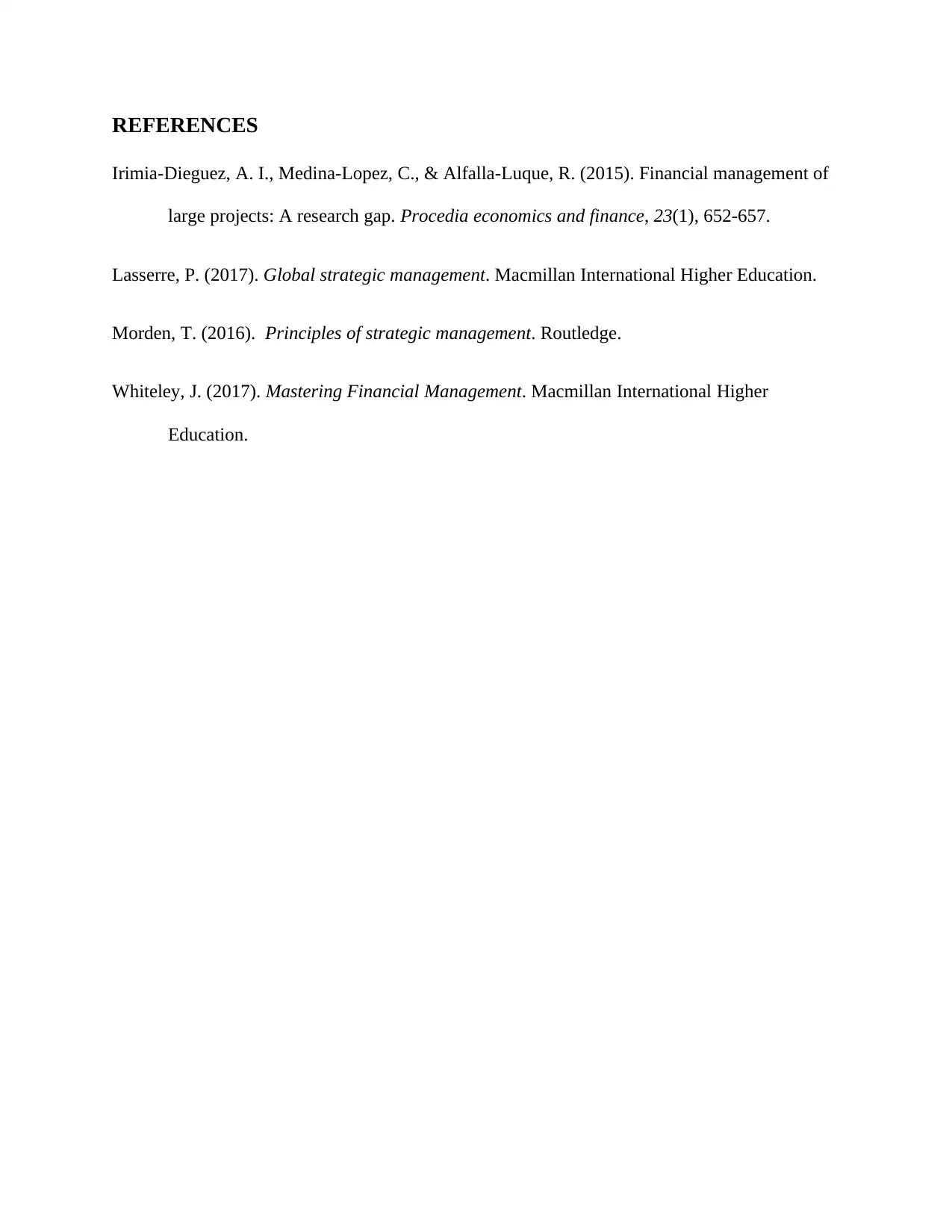
REFERENCES
Irimia-Dieguez, A. I., Medina-Lopez, C., & Alfalla-Luque, R. (2015). Financial management of
large projects: A research gap. Procedia economics and finance, 23(1), 652-657.
Lasserre, P. (2017). Global strategic management. Macmillan International Higher Education.
Morden, T. (2016). Principles of strategic management. Routledge.
Whiteley, J. (2017). Mastering Financial Management. Macmillan International Higher
Education.
Irimia-Dieguez, A. I., Medina-Lopez, C., & Alfalla-Luque, R. (2015). Financial management of
large projects: A research gap. Procedia economics and finance, 23(1), 652-657.
Lasserre, P. (2017). Global strategic management. Macmillan International Higher Education.
Morden, T. (2016). Principles of strategic management. Routledge.
Whiteley, J. (2017). Mastering Financial Management. Macmillan International Higher
Education.
1 out of 14
Your All-in-One AI-Powered Toolkit for Academic Success.
+13062052269
info@desklib.com
Available 24*7 on WhatsApp / Email
![[object Object]](/_next/static/media/star-bottom.7253800d.svg)
Unlock your academic potential
© 2024 | Zucol Services PVT LTD | All rights reserved.